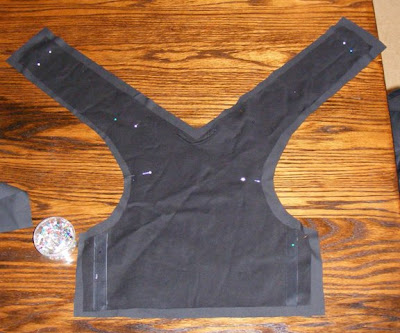It started on the first day of our holiday when, 3 hours before we were due to leave, I decided to very quickly measure up for, and order, the bones for the front of the kirtle; a post-climbing treat. Just shy of 4 hours later we were in the car. The bones were ordered and I was re-finding my inner calm, whilst Googling the answers to all my questions and, ultimately, finding ways to continue with this project. I love unlimited data :)
One thing that I was truly excited about at the start of this project was the Margo Anderson pattern and it's instruction manual; I had read great reviews of previous patterns/manuals and had great hopes. I have now read the full instruction manual a couple of times and whilst it is a combination of hints and tips, techniques and specific instructions; it is driving me slightly mad! Neverminding the errors in the instructions (the wrong piece named etc.), the most annoying thing is that they are full of holes and rely on you remembering pieces of information mentioned throughout the manual. Even with sections marked up, I have wasted (and will continue to waste) hours piecing different bits of information together from all through the manual. For example, the seam allowance is mentioned in a section on techniques but not in the instructions for making an item; or the kirtle edges are meant to be flatlined and seamed, but the flatlining instructions do not tell you how. The questioning and second-guessing saps your confidence too... I could go on and on, and would have gone slightly mad, bitching about each individual frustration. Thanks to the extra research, I learnt enough to take the plunge and just got on and did what I wanted to do; I made my kirtle. I don't know if it's as Margo would have wanted; I'm still not entirely sure it's accurate in it's fit etc. as I'm still not entirely sure how to achieve that!; but it's done and I'm pleased. This is how I did it.
The Front Bodice: I started by transposing the lines for the boning from my template to a piece of coutil; as you can see, it wasn't smooth sailing but I got there in the end!
I pinned a piece of black cotton drill to the back of the coutil and sewed in all of the channels; finishing off each end with a couple of reverse stitches and then by tying them off. Once the channels were sewn I inserted the bones; I changed my plans at the last minute and did not put the double width of bones in at the sides. To be honest, I wasn't entirely sure that I had interpreted the instructions accurately in the first place! I then basted round the sides and top of the bodice; leaving the bottom open. I then trimmed the bodice back to a couple of millimetres from the basting line, I did not trim the bottom.
I cut two more bodice pieces out of the black cotton sheeting that I am using for the kirtle, and a border out of the orange damask trim. As you can see, I cut the first piece of damask on the wonk; I cut a second, better piece.
I had cut the outer lining pieces approx half an inch bigger than the bodice and decided that, to achieve the self lined and edged finish that the instructions ask for, I would handstitch on one side first and then the other.
I pinned and then pressed the first side around the bodice and slipstitched it in place.
I then pressed the edges of the other side to match the shape and slipstitched in place along the side and top outer seams. Finally, I pressed the edges of the border piece and slipstitched in in place along the bottom and at the sides, leaving the top open.
Tudor gowns employ piping to define and shape edges. The instructions called for modern cord but I decided to use the same handknit cotton string that I had used in the hem of the Victorian skirt. I then cut a long strip of border fabric and encased the cord within it.
I slipped the piping in between the border fabric and the bodice; trimmed and then stitched closed the ends and slipstitched the piping in place.
With the exception of the bottom seam, I now had the front piece of the bodice done.
The Back Bodice: followed in much the same way. Only two bones were to be sewn in the back, and I wanted it to be softer then the front piece, so I used casing on a piece of cotton drill.
I lined it on both sides with the top cotton, using the same method as with the front piece.
Making sure that I clipped and pinned the armhole curves.
Finally, I slipstitched a border piece onto the back and piping around the neckline.
The Kirtle Skirt: I made up the skirt according to the instructions and did not stop for photos. It was simple enough, four panels plus a forepart of the orange damask which was flatlined to a lining piece of cotton. Each side seam was sewn to 7" of the waistline and finished with a placket. The seams were all handstitched closed with a french seam. The front and back panels were then pleated to fit the with of the bodice panels.
Again, the instructions were not clear about attaching the skirts cleanly to the bodice pieces. I decided to pin and machine them to the back of each panel; matching right side to right side and then folding the seam towards the top of the panel and pressing it in place.
This gives a lovely, secure, finish at the back.
It was quick and simple to then pin and slipstitch the front of the panel in place.
The bodice is laced up at both sides, so I handed my hours of handstitching over to the boyf who hammered in the eyelets for me. I don't trust myself to make a mistake with them so late in a project.
And then it was time to try it all on and fit the shoulder straps, once I'd finished playing Tudor Lady... Please ignore the black Gap vest which I wore under the corset to replicate the fabric layer of a smock. I also had the bumroll and petticoat on under the kirtle, for full effect. It's gorgeous, I love the shape, but it is heavy! I will have to take that into account when choosing fabric for the top gown. And I admire the stamina of ladies who make these costumes in upholstery fabrics, brocades and wools!
 |
| The side lacings (temporarily laced with ribbon), over the kirtle and bumroll. |
I just love the colours and am really thrilled. The top sleeves need to be added, but I couldn't resist posting now. Two weeks ago I doubted my ability, or desire, to get this done; this feels like a huge, confidence boosting step forward.


































I am in awe of your talents and so very proud of you
ReplyDeleteSo when I clicked on this I was expecting a kirtle for Elizabethan era, imagine my surprise when this is a kirtle for Henricians, if you have the pattern from Margo, pretty sure it states it is prior to Elizabethan period.
ReplyDeleteIf you have questions on the fit or cut of these patterns? You can check with Margo and others who have worked these patterns in her Yahoo Group or FB
Hi Cilean, thanks for your comment. I should explain the title of this post, with apologies for the confusion. I name all my projects, this was "Elizabeth" and so the post titles reflect that. If you look at the main project page, it is explained there. I am a member of Margo's FB group and, overall, loved her pattern... Just not this day!
Delete